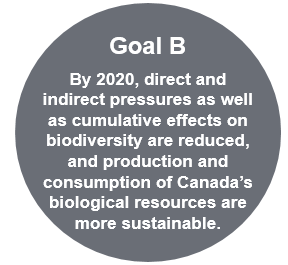Canada Target 10. By 2020, pollution levels in Canadian waters, including pollution from excess nutrients, are reduced or maintained at levels that support healthy aquatic ecosystems.
About the Target
Water quality is critical to healthy lakes, rivers and marine ecosystems. Clean water provides essential habitat for aquatic plants and animals, is necessary for human survival, supports many commercial and industrial uses, and is at the heart of many recreational activities.
Pollution enters water bodies in a number of ways, including industrial and municipal discharge, runoff, spills, and deposition of airborne pollutants. In addition, certain nutrients that are important for aquatic ecosystem health can become pollutants at high levels. For example, when too much nitrate and phosphate are added to an aquatic system, aquatic plants and algae can grow excessively leading to algal blooms.
Water pollution threatens the health of many wild species and affects overall ecosystem integrity and resilience. Action is needed to reduce pollution to Canadian waters in order to support aquatic biodiversity, protect Canada’s water resources, and ensure that essential ecosystem services that people depend on like clean water remain available across the country.
Canada Target 10 is linked with the following global Aichi target under the United Nations Convention on Biological Diversity Strategic Plan for Biodiversity 2011-2020:
Aichi Target 8 - By 2020, pollution, including from excess nutrients, has been brought to levels that are not detrimental to ecosystem function and biodiversity.
2020 Final Assessment
For the 2018 to 2020 period, water quality in rivers in Canada was rated fair to excellent at 83% of the monitored sites. However, where water quality has changed between 2002 and 2020, more sites (30%) have deteriorated than have improved (10%). Nutrient pollution is still a continuing problem in major watersheds in Canada. For the 2017-2019 period, phosphorous and nitrogen levels exceeded water quality guidelines at most monitoring stations in the St. Lawrence River. In 2020, phosphorous loading to Lake Erie from all sources within Canada and the United States (9,336 tonnes) was relatively average compared to the last 12 years. In 2019, phosphorus levels were too high in the offshore waters of Lake Erie. While average concentrations in the offshore waters of Lake Ontario, Lake Huron and Georgian Bay were found to be low in 2020, many critical nearshore areas are experiencing nuisance algae problems due to excessive concentrations of nutrients.[i] For marine coastal water, the proportion of shellfish harvest area classified as approved or conditionally approved for harvest for human consumption is a partial measure of quality, and this measure has remained consistent in recent years.
The target has not been met given that major regional basins show no significant improvement with respect to nutrient pollution. Overall water quality ratings do not show a strong improvement and there may be an overall net deterioration in water quality. Releases of harmful substances including plastics continue to be a concern.
There has been progress in some areas and new initiatives are being put in place (see Contributing Actions). The issue touches on many aspects of human activity and the environment such as farming practices, source water protection, wetland conservation, extractive industry operations and releases to the environment of plastics and other products. Cross cutting work will be required to make improvements and accelerate progress.
[i] Environment and Climate Change Canada and U.S. Environmental Protection Agency (2020) State of the Great Lakes 2019 Highlights. (Accessed: 3 May 2022).
Contributing Actions
Canada’s Great Lakes Protection Initiative combines science and action to advance priorities in the basin, including preventing toxic and nuisance algae in Lake Erie. To assist in achieving this goal, Canada has provided funding since 2017 to partner-led projects that implement innovative approaches and best practices for reducing phosphorus loads and promoting broad uptake and application. In 2021, the Government of Canada invested more than $3.1 million over three years in thirty-two new projects that will contribute to preventing toxic and nuisance algae, restoring water quality and ecosystem health in Areas of Concern while enhancing engagement with Indigenous peoples and the public.
In June 2019, Ministers of Environment approved the Canada-wide Action Plan on Zero Plastic Waste: Phase 1, which focuses on: product design, single-use plastics, collection systems, recycling capacity and domestic markets. In July 2020, they approved the Canada-wide Action Plan on Zero Plastic Waste: Phase 2, which focuses on: consumer awareness, aquatic activities, research and monitoring, clean-up and global action. Together, phases 1 and 2 lay out concrete measures to keep plastics in the economy and out of the environment. Federal, provincial and territorial governments worked together and with a broad range of stakeholders and interested parties to identify the priority actions in the action plan.
Source water protection is a management strategy designed to minimize the impacts that human activities and natural events have on drinking water sources, and it is a consideration among many municipalities and Indigenous communities across Canada. Ontario has local source water protection plans covering an area where most of the population lives. Source water protection is an important part of Quebec’s 2018-2030 water strategy. Other provinces and territories include source water protection guidance or supporting legislation. Some Indigenous communities are developing source water protection plans. In 2014, the federal government prepared a guide for developing on-reserve source water protection plans. Since 2017, some First Nations and the Canadian Environmental Law Association (CELA) have undertaken a collaborative, community-based project to identify threats to source waters in the Indigenous communities along the Thames River, and develop legal tools and policy aimed at their protection.
Source water protection is a form of conservation that benefits biodiversity and contributes to climate nature-based solutions. Source water protection planning is a process that tends to be led at the local level but stronger support from higher government levels with funds, standards, expertise and guidance would encourage broader adoption and significant contributions to Canada’s conservation targets.

